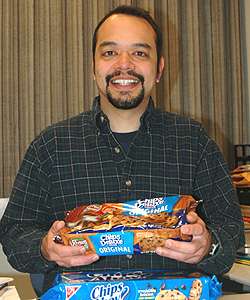Chocolate chip cookies help make statistics lessons relevant and palatable

Chocolate chip cookies aren't just a favorite after-school snack. They're also a rich source of statistical data, according to Herbie Lee, an associate professor of applied mathematics and statistics at the University of California, Santa Cruz, Baskin School of Engineering.
In an article in the November 2007 issue of American Statistician entitled, "Chocolate Chip Cookies as a Teaching Aid," Lee describes how he has used these tasty and comforting props to teach statistical concepts, such as random distributions and hypothesis testing.
Many people are required to take a course in statistics as preparation for a wide variety of careers in research, business, and public policy. But few look forward to it. According to Lee, teachers of statistics often face a classroom full of students who are poorly motivated to learn and downright fearful of mathematical concepts.
When he brought chocolate chip cookies into his classroom, however, Lee discovered that the beloved treats provided an easy and effective way to excite a broad group of learners. "The students loved the cookie examples," he said.
Lee teaches university undergraduates, but his methods could also be used to introduce basic concepts of statistics--such as variability--in high school or middle school, he said. From the course evaluations he has received from hundreds of students, Lee has learned that cookie examples seem to help people pay attention in class. And, presumably, that means more students grasp the importance of statistics in everyday life, he said.
"There's a lot of variability in the world, so we need methods to help us make decisions in the face of uncertainty," Lee said. "It's not intuitive and not something humans do well. Getting a better feeling for randomness and for why statistics is useful is a really important and valuable lesson."
Four years ago, Lee was looking for a better way to bring this message home to undergraduates. Standard textbook examples for statistical concepts usually came from sports, biology, and economics, but these resonated only with certain groups of students, he said. So he decided to try a hands-on demonstration using chocolate chip cookies, something nearly everyone could appreciate.
During a lecture, he pulled out a bag of cookies and suddenly the students paid attention, he said. Then he gave a cookie to each student and asked him or her to count the number of chips (which requires carefully eating the cookie, since not all the chips can be seen from the outside). Lee graphed the data, showing a Poisson distribution, which is close to a classic bell curve in this case.
"The number of chips match what we expect statistically, but not what we know intuitively," Lee explained. "The students don't expect individual cookies to be that different, but they are. This example shows that variability is all around us, even in something like mass-produced cookies."
Math teachers have been known to spice up their lessons with various kinds of food items, including M&M candies, Hershey's kisses, and chewing gum. But these are usually "one-trick ponies," said Lee. Chocolate chip cookies, on the other hand, can be used to illustrate many key statistical concepts. That's why Lee developed ways to use cookies as a repeating theme in his course. He uses them as examples leading into discussions about measurement error, data display (such as histograms), extreme values, outliers, hypothesis testing, and analysis of variance.
For instance, when it came time to study two-sample t-tests, Lee brought in a second brand of cookies. The students got excited, he said, as they tried to figure out how to compare the difference in brands in light of all the variability between individual cookies. And, of course, they got to eat more treats.
Lee has even found chocolate chip cookies helpful for teaching graduate students about Bayesian analysis, a method for dealing with uncertainty that requires starting with an educated guess, or "prior."
"It's interesting because the students' initial guesses on the number of chips are usually very wrong," he said. "They find out what happens when their guesses are fairly far off, and how much they can update their prior by collecting real data."
Lee now has developed protocols that he plans to use in his statistics courses for the foreseeable future.
"If I hook students with the cookies, I find they keep coming to lectures for the rest of the course," he noted. "It has worked so well, now I use the cookies as much as I can."
Lee's article is available on his web site.
Source: University of California, Santa Cruz





















